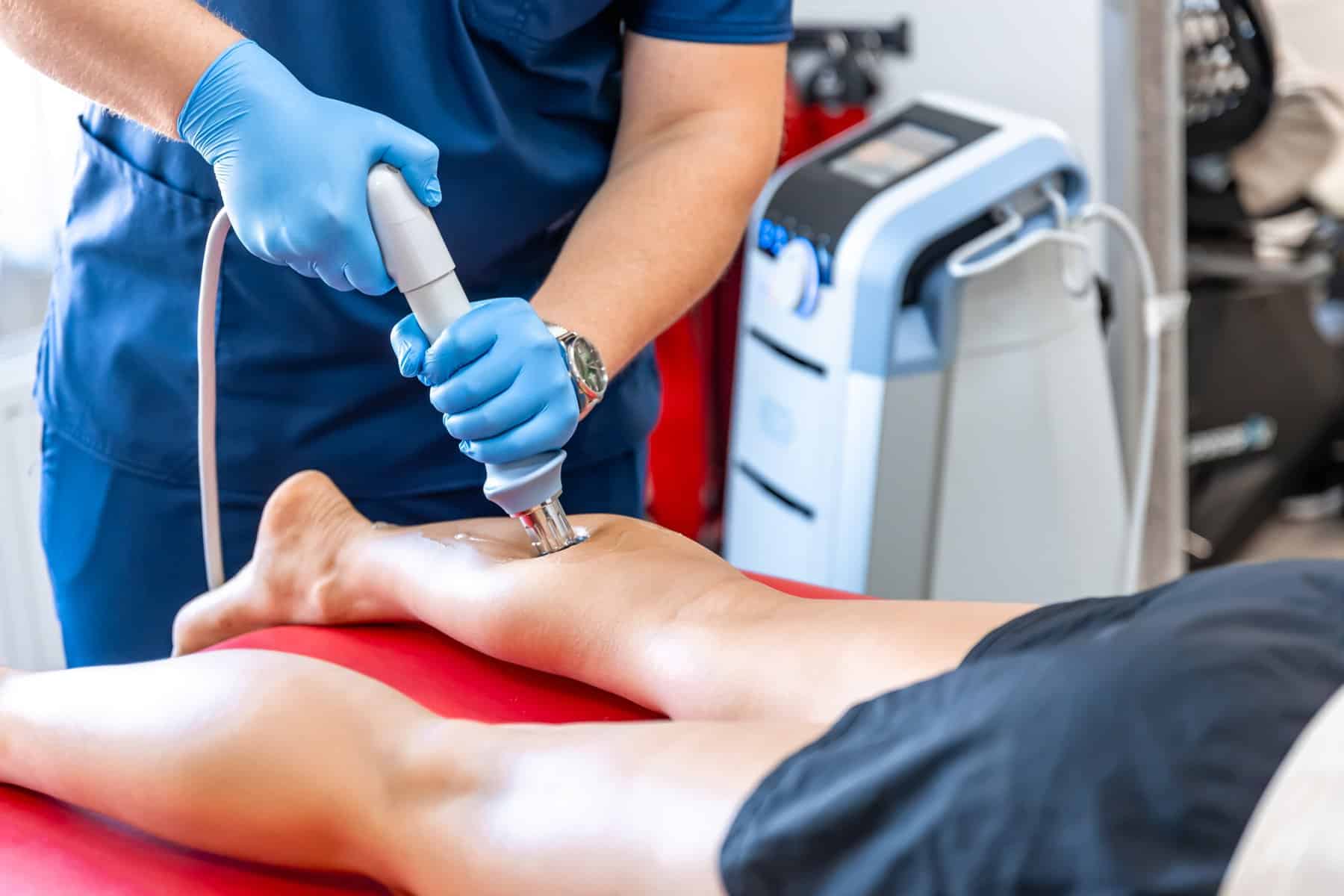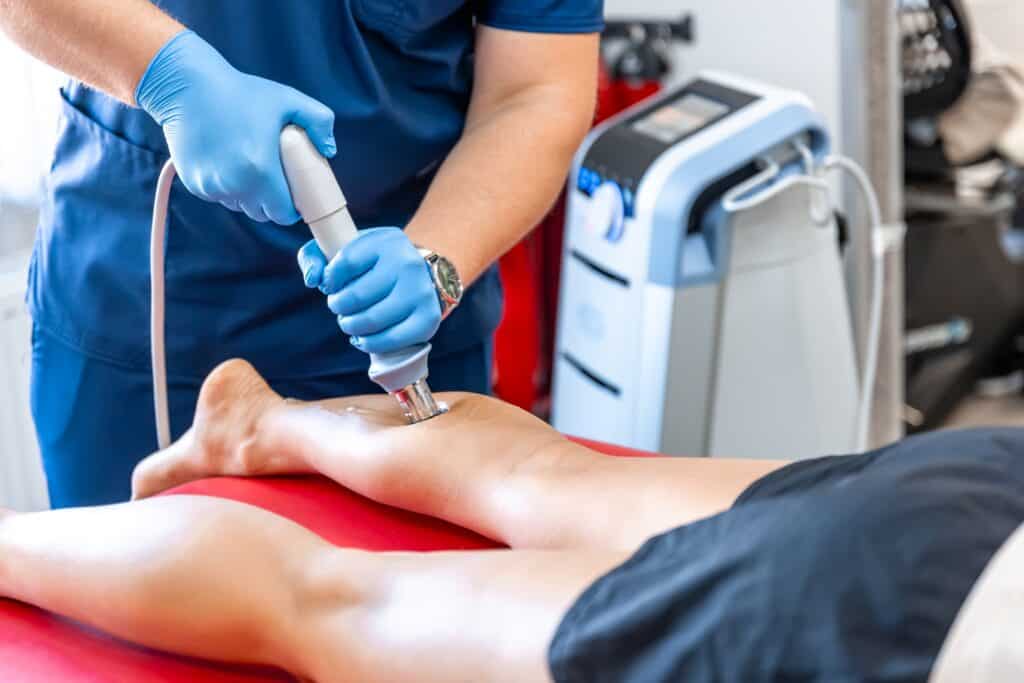
What Is Shockwave Therapy and How Does It Work?
Radial Shockwave Therapy is a new, non-invasive way to promote healing and reduce pain in musculoskeletal injuries and conditions. It uses high-energy acoustic sound waves, to accelerate the body’s natural healing processes, increasing blood flow and metabolism.
Shockwave Therapy targets specific areas to create controlled micro-trauma, increased blood flow, stimulate new blood vessel growth, and promote tissue regeneration. It’s particularly effective in increasing blood flow to tendons, which have a lower blood supply and heal more slowly than muscles.
Treatments are quick, usually 5 to 10 minutes, and often go with other physiotherapy therapy work or home exercises.
What Conditions Does Shockwave Therapy Treat?

Commonly treated conditions include:
- heel spurs
- plantar fasciitis
- Achilles tendinopathy
- tennis elbow
- Jumper’s Knee (Patellar Tendonitis)
- Shin Splints
- Hip bursitis
- Trigger Points/Muscle Pain
The therapy is particularly beneficial for treating conditions related to connective tissues such as tendons and ligaments.
What are the benefits of Shockwave Therapy for patients with lower limb conditions?
The benefits of Shockwave Therapy over other treatment options include faster healing, improved circulation, and less pain sensitivity. It’s a non-invasive, low-stress alternative to surgery or medication, that harnesses the body’s healing powers.
Our patients often experience relief and recovery within just a few sessions of treatment.
Overall, radial shock wave therapy enhances recovery by:
- Effectively breaks down calcific deposits in tendons
- Promotes collagen synthesis and repair of injured tissues
- Decreases the levels of Substance P, contributing to a significant reduction in intense and chronic pain.
- Repairing musculoskeletal damage
- Alleviating chronic pain
- Improving the quality of life.
But the benefits of shockwave therapy don’t stop there. The therapy is also observed to:
- Aid bone healing after fractures
- Reduce severity in early-stage knee osteoarthritis
- Significantly lower pain in cases like calcified tendinopathy of the shoulder.
While corticosteroid injections offer short-term pain relief in conditions such as plantar fasciitis, shockwave therapy provides more durable with virtually no side effects with benefits lasting beyond 6 months.
Also, shockwave therapy avoids risks like heel damage or plantar fascia tear, which can happen with corticosteroid shots.
What can patients expect during a Shockwave Therapy session?

Shockwave therapy starts with an assessment and physical exam by a podiatrist. Patients should wear loose clothes so the therapist can easily reach the treatment area.
During first treatment, the podiatrist locates the spot that needs treatment and applies ultrasound gel on the contact area to aid the shockwave device.
Then a hand held probe delivers controlled acoustic waves for approximately 5-10 minutes for each injured area. The treatment might feel like pressing on a bruise, but the therapist can adjust the intensity if needed.
Post-treatment, most patients can usually resume normal activities immediately. But it is advised to avoid strenuous activities for 48 hours. Some may experience mild temporary soreness, tenderness, or swelling which is normal. Pain medications or ice therapy are not recommended as they might interfere with the healing process.
Measuring the Impact: How Many Treatments and Expected Outcomes
The best results from shockwave therapy usually show up 8 to 12 weeks after treatment, with outcomes lasting long-term. Some patients feel better after their session. The number of treatments needed for the best results can vary depending on the problem being treated and how severe it is.
Relief often comes right after the first session. For the best results, sessions are set 3-10 days apart, with a total of 3 to 6 sessions needed, and may be scheduled annually or bi-annually. Patients with chronic conditions may require ongoing treatment at weekly intervals to experience lasting results.
About 91% of patients in clinical studies say shockwave therapy worked for them, reducing chronic pain and improving movement.
Safety Profile and Potential Side Effects of Shockwave Therapy
While shockwave therapy is generally safe, it may induce temporary side effects like pain, tenderness, bruising, swelling, and numbness at the treatment area.
Shockwave therapy may not be a suitable treatment for everyone. It’s contraindicated for patients with specific conditions such as:
- circulatory or nerve disorders
- infections
- kidney stones
- bone tumours
- metabolic bone conditions
- pregnancy
- ruptured tendons
Tailoring Your Treatment Plan with Expert Care
Shockwave therapy isn’t a one-size-fits-all solution. A comprehensive evaluation with an experienced podiatrist like Dr Richard Chasen is the first critical step. They’ll analyse your history and day-to-day activities, your biomechanics and your gait and make a custom treatment plan that may include shock wave therapy and other treatments.
So, if you’re battling chronic pain and seeking treatment that can tip the scales in your favour, consider shockwave therapy at our clinical practice in Elsternwick, Melbourne.
Get a Gap-Free Biomechanical Assessment and Gait Analysis
If you’re suffering from lower limb pain, balance problems, or other lower limb conditions, book a biomechanical assessment and gait analysis with The Lower Limb Clinic.
New patients can get their assessment Gap-Free! But it’s limited to 3 spots per week so book early.
